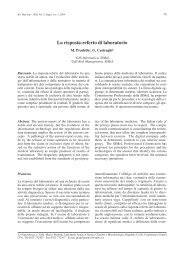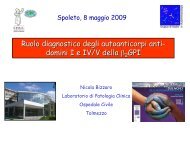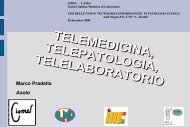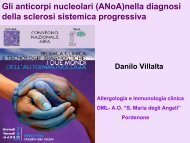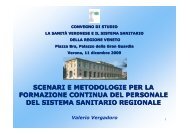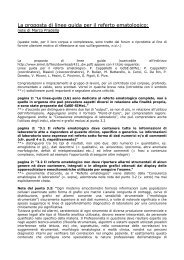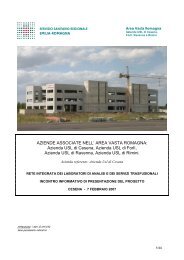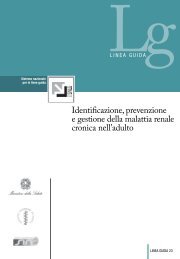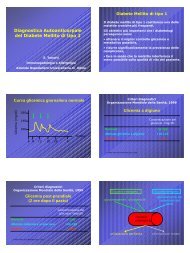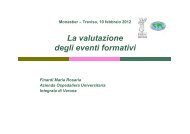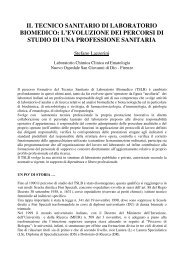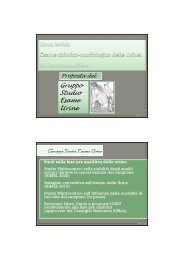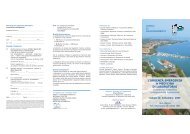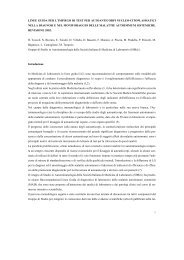Il ruolo delle Società Scientifiche - Simel
Il ruolo delle Società Scientifiche - Simel
Il ruolo delle Società Scientifiche - Simel
Create successful ePaper yourself
Turn your PDF publications into a flip-book with our unique Google optimized e-Paper software.
<strong>Il</strong> <strong>ruolo</strong> <strong>delle</strong><strong>Società</strong> <strong>Scientifiche</strong>Piero Cappelletti
La nascita <strong>delle</strong> <strong>Società</strong><strong>Scientifiche</strong>
La crescita <strong>delle</strong> societàscientifichehttp://www.lib.uwaterloo.ca/society/
Le <strong>Società</strong> MedicheThe New Jersey Medical Society,the first organization of medicalprofessionals (1766), was developed to"form a program embracing all thematters of highest concern to theprofession: regulation of practice;educational standards for apprentices;fee schedules; and a code of ethics.”
Le ragioni <strong>delle</strong> <strong>Società</strong><strong>Scientifiche</strong>•Difesa degli interessi professionali e forumdi arbitrato (advocacy)•Network di scambio di informazioni(congressi, giornali, incontri)•Ruolo nella ricerca scientifica e nel suoriconoscimento (EBM, GL)•Ruolo nella formazione (training &education) e nella definizione di qualità ecompetenza
Professional MedicalAssociations...la misión de una sociedad científica: 1) defender losintereses de los especialistas a los que representa, y2) velar por la calidad de su competencia y, portanto, de los servicios que prestan a los pacientes ya la sociedad...JA Prados CastillejoCastillejo 2009The history of professional medicalassociations reflects a constant tensionbeween self-interest and ethical ideas:this conflict has never been resolved…ED Pellegrino, AS Relman 1999
The role and duties of scientificmedical society•German Society of Dermatology (DDG)•Questionnaire: motive (9 items), image (13 items),usage (7 items), expectations (10 items) + 2 openfree answers to “future concerns”and “how tostrengthen profile”•28% (931/3277) response, balanced betweenscientifically active members (W; 46.7%) e nonactivemembers (non-W; 51.8%)•Age distribution: 70 2.9%P Hensen et al 2009
Perché ci si associa ad una <strong>Società</strong>•Possibility of futuretraining 90.8% (p)•New developments90.7% (p)•Journal79.7% (p)•DDG representative inEurope 77.9%•To support scientificdermatology 73.3% (p)•Exchange with othercolleagues 58.6% (p)Scientifica?•Politicalcommitment30.5% (p)•Professionalcareeer 28.8%(p)•Recommendationsof colleagues oracquaintances20.5% (p)P Hensen et al 2009
Cosa si usa di una <strong>Società</strong>•The Journal90.5%•Saving onMeetings73.9%P Hensen et al 2009Scientifica?•www information37% (p)•www online service22.6% (p)•Working groups26.3% (p)•Partecipation onpanels20.2% (p)•Service of DDGoffice18.5% (p)
Cosa ci si attende da una <strong>Società</strong>Scientifica per il futuro?•Training and additionalqualifications 86.3% (p)•Health policy issues81.6%•Guidelines80.1% (p)•Scientific networking73.6% (p)•International activity70.2% (p)P Hensen et al 2009•E-learning 66.2% (p)•Restructure CPD57.6%•Qualification forleading position 55.3(p)•Counseling onpromote research52.6% (p)
Cosa ci si attende da una <strong>Società</strong>Scientifica per il futuro?P Hensen et al 2009
<strong>Società</strong> Scientifica:un’area di conflitto di interessi diversi•Non W: higherdemands ofservices by scientificsociety; specialtytraining andcontinuingeducation in thecenter ofmembership;promotion ofphysicians’interest inprofessional andhealth policy•W: promotion ofresearch andscientificnetworking;scientific society asan infrastructuralorganization creatingstructures and offersto enhanceresearchP Hensen et al 2009
Prospettive di una <strong>Società</strong>Scientifica•Both (non-W involvement &coordination with professionalassociations) can be achieved throughbetter networking within the medicalsociety.Only when leaders and members of a medicalsociety remain in continual motion and coordinategoals and strategy with each other duties andactivities can be fulfilled successfully.P Hensen et al 2009
Serving the needs of graduateand postdoctoral students•Reasons for joining SSR: 1) annual meeting;2)sharing research•Value of belonging to SSR: 1) networking; 2)staying informed; 3) feedback to research; 4)annual meeting; 5) job opportunity; etc.•About career: 1) networking; 2) learning ; 3) jobopportunities•Improving membership: 1) spreadinginformation about SSR; 2) introducing people toSSR; 3) volunteering for committeesJM Bahr 2008
A Membership Crisis•Scientific Societies represent the shared interestamong professionals to foster internal, andincreasingly external, communication to maintain aproductive professional environmentSociety membership is an essentialcomponent of professional development:like a coin, one side is opportunity and theother is responsabilityMW Schwartz et al 2008
CME e CPD•CME constitutes educational activities that serve tomaintain, develop, or increase the knowledge,skills, performance, and the relationships aphysician uses to provide services for patients, thepublic, or the profession.www.ama-asna.orgasna.org•The European Union of Medical Specialists(UEMS) defines CPD as the educative means ofupdating, developing and enhancing the waydoctors apply the knowledge, skills and attitudesrequired in their working lives.www.uems.net
CME & CPD•There is no sharp division betweencontinuing medical education and continuingprofessional development, as during the pastdecade continuing medical education hascome to include managerial, social, andpersonal skills, topics beyond the traditionalclinical medical subjects.•The term continuing professionaldevelopment acknowledges not only thewide ranging competences needed topractise high quality medicine but also themultidisciplinary context of patient care.C Peck et al 2000
CPD: the role of ScientificSocieties•“Political”activity national/international favouringCME/CPD•Coordinatinga network of stakeholders in CPD•Definingfields to be covered, plans for training,research on evaluation methods•Improving their educational competence•Helping decrease the dependance on time as asurrogate for competenceC Carbon 2005
Motivating factors•Awarnessofresponsability forsafe medicalperformance•Recognitionofpeers•Collectiveemphasison the quality ofmedical practiceC Carbon 2005• Lack of compensation• Improving performanceas no value-addedadded andtime-wasting• Lack of basic tools foroutcome andperformancemeasurements• Failure of teachers inimproving skills
Putting the learner at the center•Is CME/CPD effective?•Quality of education•Needs assessment•Performance and outcomeassessment•Maintenance of Certification andSelf-directed learning
American College of Chest PhysiciansEvidence-BasedEducational Guidelines• The American College of Chest Physicians proposedand obtained support from the Agency for HealthcareResearch and Quality to identify and synthesize theevidence addressing effectiveness of CME.• The Agency for Healthcare Research and Quality awardedthe Johns Hopkins Evidence-Based Practice Center(EPC) funding to perform a systematic review of theliterature to answer several key questions regarding theeffectiveness of CME.• That review (CHEST 2009; 135 Supplement) and itsassociated report form the basis of … guidelines, which isintended to inform medical teachers and learners.
Effectiveness of CMEClinical Outcomes: n. 33; 42%Performance: n. 105;58% (50% long-term)Skills: n. 15; 47% (70% l-t)Attitude: n. 31;71% (68% l-t)Knowledge: n. 28;78% (68% l-t)
Effectiveness of CME•Despite low grade evidence and heterogeneity ofthe studies, recommendations suggest the use ofmultimedia, multitechnique and multipleexposures CME for knowledge, attitude,performance ,and clinical outcome•Most studies that evaluated the impact of differenttypes of CME media on performance found thatuse of single live media had both a short- andlong-term effect on practice behavior objectives,and that single print media is ineffective.•Most of the studies about knowledge applicationthat met their skill objectives had multipleexposures to the CME activity as did most of thestudies that evaluated the long-term effect onskills.
From Evidence to Guidelines•Definizioneesplicita degliobbiettivi•Chiaradescrizione dellastrategia diricerca•Chiaradescrizione deicriteri d’inclusionee di esclusionedegli studi primari•Valutazione dellaqualitàmetodologicadegli studi primari•Presentazionedei risultatiStudi singoliRevisioni sistematiche (RS)Metanalisi: RSin cui i risultatinumerici deglistudi primarisono combinatistatisticamenteStudi clinicirandomizzatiLivelli dievidenzaStudiprimariLinee Guidaper la PraticaClinica
Evidence-Based Laboratory MedicineAtestNecessità clinicaDIFFICOLTÀBNecessità clinicaDecisione/AzioneInterventotestInterventoOutcome•Outcome surrogati•Accuratezza diagnosticaOutcomeD Giavarina 2004
Accuratezza Diagnostica•Pochi studi dedicati all’accuratezza•Accuratezza come obiettivo secondario degli studi•Difformità tra gli studi•Non corretta identificazione del target diagnosticoD Giavarina 2004
Indagine sull’utilizzo dei marcatoricardiaci in ItaliaLINEE GUIDA E PROTOCOLLI27% 27%4% 4%28% 28%41% 41%sì sìLG, sì sìProtocollisì sìLG, no noProtocollino noLG, sì sìProtocollino noLG, no noProtocolliGA Galli, M Caputo et al 2005
Perche no?Why don’t physicians follow clinicalpractice guidelines?knowledge attitudes behaviorLack of FamiliarityLack of AwarenessTurnover50% mediciDEInformation volumeTime neededGL AccesibilityLack ofAgreementspecific GLEvidence, Applicability,Not cost-benefitbenefit,No confidenceGL in generalCookbok, Rigid, Biased,Clinical Autonomy,Not practicalLack of outcomeexpectancyLack ofself-efficacyLack ofmotivationExternal BarriersPatientStudies may not be generalizable, since barriersin one setting may not be present in another27% deicardiologiGLEnvironmentTime, Resources,Organization,Reimbursement,Malpractice laibilityMD Cabana et al 1999Medicinadifensiva
Needs AssessmentNeeds assessment in the future of CME will bemultidimensional1. Assess the learner needs by performanceassessment (EBM guidelines; gaps & barriers)2. Avoid the potential “blind spot”of Physicians3. Close the loop with the learner with feedeback onthe performance changeResources by professional societies allowphysician partecipation, without tne need to developtools of their own.MM Lowe et al 2009
Self-assessmentof needs•Multiple Choice Questionnaire for self-assessmentat Swiss Societies of Rheumatology andPhysical Medicine (94.9% response)•60.9% found it useful to assess rheumatologicalknowledge•71.3% for anonimous feedback; 47.2%individualised•26.3% favoured revalidation (private No OR 2.09)•No individualised OR 7.95 No revalidationC Beyeler et al 2004
Self-assessment of needsC Beyeler et al 2004
Self-assessment of needsC Beyeler et al 2004
Outcome Assessment•Written Examinations•Assessments by Supervising Clinicians•Clinical Simulations•Multisource (“360-Degree”)Assessments•Portfolios•Audit & FeedbackR Epstein 2007
Audit in AutoimmunologiaRicadute organizzative10,20%17,50%questionariodopo 6 mesi137/34024,10%21,90%20,40%21,20%0,00% 5,00% 10,00% 15,00% 20,00% 25,00% 30,00%Nessuna risposta 14/137Modifiche metodologiche 24/137Introduzione di nuovi test 33/137Introduzione di algoritmi diagnostici 30/137Espressione del quadro fluoroscopico nel referto 28/137Modificazione del valore soglia di positività del test ANA-IFI 29/137R Tozzoli et al 2003
Audit in AutoimmunologiaEfficacia della riorganizzazioneMiglioramento della qualitàdella prestazione diagnostica27/4055%30%45%67.50%Riduzione del tempo dirisposta 18/40Miglioramento dei rapporti coni clinici 12/40R Tozzoli et al 2003Razionalizzazione e migliorimpiego <strong>delle</strong> risorse 22/40
Future Implications for Providers•CME as value center•Resource and support are critical•Ridesign methods, integratingnoneducational strategies•Research agenda focused on technologyand environmental factors•Leadership to guide the professionMM Lowe et al 2009
ECM: PSN 2003-5Ancora, le <strong>Società</strong> <strong>Scientifiche</strong> dovranno trovare ampiavalorizzazione nel sistema della formazione continua,garanti non solo della solidità <strong>delle</strong> basi scientifichedegli eventi formativi, ma anche della qualità pedagogicae della loro efficacia.Da ormai molti anni la maggior parte <strong>delle</strong> <strong>Società</strong> Medico<strong>Scientifiche</strong> Italiane si è riunita nella Federazione Italiana<strong>delle</strong> <strong>Società</strong> Medico <strong>Scientifiche</strong> (FISM), che ha operatoper dare agli specialisti italiani un <strong>ruolo</strong> di interlocuzionecon le Istituzioni, inteso primariamente come contributoculturale ed operativo all’identificazione ed allo sviluppo<strong>delle</strong> attività sanitarie e mediche nel Paese. Oggi le <strong>Società</strong><strong>Scientifiche</strong> hanno trovato pieno riconoscimento del loro<strong>ruolo</strong> per l’ECM, la cui organizzazione si è così arricchitadi risorse culturali ed umane.
Ruolo <strong>delle</strong> <strong>Società</strong><strong>Scientifiche</strong> ed ECM•una analisi dei bisogni capillare tra i membriinteressati alla formazione, un contributo allaidentificazione <strong>delle</strong> priorità, il rilevamento di temiemergenti;•la rilevazione della complessità di un singoloargomento e la ricaduta nella sua applicazione supiù categorie di Operatori, quando previstenell’articolazione societaria (medici, laureati nonmedici, tecnici,…);•quindi, l’individuazione dei percorsi per disciplina;•attività di tutoraggio e tracce per la definizione diprofili/percorsi formativi da proporre e/o adattare peri diversi Operatori presenti nelle <strong>Società</strong> <strong>Scientifiche</strong>;DocuSIMeL 2007
Ruolo <strong>delle</strong> <strong>Società</strong> <strong>Scientifiche</strong>ed ECM•una verifica nel tempo della penetranzadell’intervento ECM e della sua ricadutateorico-pratica;•investimenti specifici sulla formazione diformatori (corsi per ADF) e/o tutor(formazione dei formatori);•la condivisione dell’onere formativo con altriProvider, con l’apporto di più punti di vistanella realizzazione dei progetti(multidisciplinarietà).DocuSIMeL 2007
<strong>Il</strong> problema dell’indipendenzaCome si fa a garantire l’indipendenza ?Schematicamente, sono state proposte due strade.Da un lato c’èquella <strong>delle</strong> regole di comportamentoformali, che distinguono ciò che è permesso da ciò che èvietato, e che chiedono a volte un’esplicitaautocertificazione dell’appropriatezza. In questa stradavedo molta ipocrisia.Dall’altro c’èla strada della co-responsabilizzazione traorganizzazioni sanitarie e industria, possibilmente suprogrammi importanti e di innovazione. Qui vedoprospettive interessanti.M Biocca 2007
E’nostra ipotesi invece che si possa farecompletamente a meno della sponsorizzazioneprivata se l’ECM è organizzata:‣ in lavoro a piccoli gruppi, in reparto, in ambulatorio, inlaboratorio, nelle sedi dei servizi territoriali;‣ con obiettivi di miglioramento della qualitàdell’assistenza, che si raggiungono con gruppi di lavorotra pari, basati sull’esame critico e sul confronto dellapropria pratica clinica (audit e feed-back), con stage, conmetodologie appropriate di formazione sul campo(progetti di miglioramento e di ricerca-interventofinalizzati a risolvere criticità, adozione concordata diprotocolli, ecc).
Conflict of Interest•Many providers of accredited continuingmedical education—a usual requirement forrelicensure of physicians—receive themajority of their funding from industry.•The report recommends a broad-basedconsensus process to develop a new systemfor funding high-quality accredited continuingmedical education that is free of industryinfluence.•The committee recognizes that such asystem may involve higher costs forphysicians and require cost-cuttingsteps by education providers.IOM 2009
Conflict of Interest•The committee recommends thatprofessional societies and other groupsthat develop practice guidelines notaccept direct industry funding for guidelinedevelopment and generally excludeindividuals with conflicts of interest from thepanels that draft the guidelines.•In addition, these groups should makepublic their conflict of interest policies,their funding sources, and any financialrelationships panel members havewith industry.IOM 2009
Scientific Societies and Promotion ofthe Responsible Conduct of Research•The first is through codes of conductencouraging their membership to practice ethicalresearch according to the tenets of these codes.•The second is through specialized policies (e.g.,publication practices) developed by scientificsocieties that help define normative behavior.•Finally, societies have a role to play in creatingmaterials and resources aimed at educatingscientists and trainees in matters pertaining toproper research conduct.FL Macrina 2007
•Identifying information.•The work under consideration forpublication.•Relevant financial activities outside thesubmitted work.•Financial relationships involving yourspouse or partner or your children (under18 years of age).•Non financial associations.
Professional Medical Associationsand Their Relationships With Industry•General budget support: zero%, except for incomefrom journal advertising and exhibit hall fees(immediatly 25%)•Annual &Regional meetings: no influence or conflictof interest in programs, gifting, satellite symposia•Funds for research: no for specific ones•Fellowships and Training Programs; Productendorsement; Affiliated Foundations: no•Practical Guidelines: disclosure is not enough•Publications: advertising must be clearly identified•Presidents & Board: no personal conflict duringservice (2 years before)DJ Rothmann et al 2009•Guidance for PMA members
Rapporto tra <strong>Società</strong> <strong>Scientifiche</strong> eIndustria: SIMeL 2007SIMeL definisce come segue i punti di repere perla ri-definizione dei rapporti con l’Industria:1. Si ribadisce l’assoluta indipendenza di giudizio,di elaborazione concettuale e di valutazione diperformance da parte di SIMeL relativamente aicontenuti tecnici, professionali, organizzativied etici della Medicina di Laboratorio. A tal fineSIMeL si impegna ad attuare sempre piùestensivamente i contenuti dell’Appello CIRBcon l’evidenza della dichiarazione dei conflittidi interesse nelle attività congressuali e deglistrumenti informativi/formativi della <strong>Società</strong>(RIMeL e Portale). DocuSIMeL 2007
Rapporto tra <strong>Società</strong> <strong>Scientifiche</strong> eIndustria: SIMeL 20072. Si ribadisce l’impegno di SIMeL per la ridefinizione di unanuova ECM efficiente e trasparente, in cui unici Provideraccreditati siano la Aziende del SSN e le <strong>Società</strong> <strong>Scientifiche</strong>certificate. Enti commerciali / industriali non possonoorganizzare attività ECM né direttamente né indirettamente, mapossono dedicarsi ad attività promozionali e di training, a loropiù consone.3. Si ribadisce l’impegno di SIMeL a razionalizzare le attivitàcongressuali e scientifiche. SIMeL da sempre ha eliminato lamostra strumentale dal proprio Congresso Nazionale ed èsempre stata molto attenta ai costi inerenti le attivitàcongressuali, tenendo sotto stretto controllo la valorizzazioni<strong>delle</strong> opportunità offerte all’Industria.
Rapporto tra <strong>Società</strong> <strong>Scientifiche</strong> eIndustria: SIMeL 20074. SIMeL dal 1990 attua Corsi residenziali ispirati ai principi e allaprassi della formazione continua anglosassone, con rigorosacondotta sociale ed intensivi apprendimenti sul campo.5. Deve essere chiaro che la razionalizzazione si attua sulla basedella massimizzazione della qualità e che i depositari deglistrumenti per giudicare la qualità e l’utilità degli eventi sono iprofessionisti e le <strong>Società</strong> <strong>Scientifiche</strong>, non l’Industria, cheovviamente giudica secondo il ritorno economico.6. Deve essere, inoltre, altrettanto chiaro che non è accettabileuna razionalizzazione <strong>delle</strong> attività scientifiche <strong>delle</strong> <strong>Società</strong><strong>Scientifiche</strong> per consentire una proliferazione di attività di Ditta,il cui contenuto scientifico è spesso di dubbio valore.
Altri conflitti di interesse ?•Espansione attività promozionali diDitta come surroga ad attivitàculturali <strong>delle</strong> <strong>Società</strong> <strong>Scientifiche</strong>•ECM istituzionale: obiettivi aziendali;qualità aziendale (rischio di logichefunzionali e provinciali)•ECM nazionale: problemi di equità,efficienza, trasparenza‣scelta dei provider (cattiva lezione del2002)‣Utilizzo dei proventi: >16.000eventi/anno; 5-10 mln €
Formazione e <strong>Società</strong><strong>Scientifiche</strong>•“<strong>Il</strong> singolo professionista deve essere messonella condizione di gestire la qualità dellapropria formazione scegliendo le attivitàECM che gli sono più utili per un’effettivacrescita professionale”.L Vettore 2007L Vettore 2007•Le <strong>Società</strong> <strong>Scientifiche</strong>, se ben strutturate,sono in grado di cogliere bisogni e desiderispecifici a livello del loro emergere•Le <strong>Società</strong> <strong>Scientifiche</strong> sono in grado dimodulare in modo flessibile e quasipersonalizzato le attività formative richieste.
Ruolo <strong>delle</strong> <strong>Società</strong> <strong>Scientifiche</strong>•In Italia si stima che 120.000 medici aderiscano alle<strong>Società</strong> <strong>Scientifiche</strong> e credo si possa dire che sianoidentificabili come la parte attiva della professioneinteressata alle problematiche della promozionedella qualità con le necessarie ricadute positive per ipazienti•La nostra <strong>Società</strong> si pone con forza all’interno diquesto movimento … si chiede di poter e volercontinuare il lavoro intrapreso con obiettiviimportanti ed ambiziosi come l’Accreditamento <strong>delle</strong><strong>Società</strong> <strong>Scientifiche</strong> … e il loro direttocoinvolgimento nelle tematiche della FormazioneP Rizzotti 2000
Le <strong>Società</strong> Mediche del futuro?The oldest medical societywas founded in Edinburghin 1737, and Dr. Remmet,first (1794)President of thePlymouth Medical Society,had been a member of this.The Society’s members met “on the evening of theFriday nearest the full moon”...to ensure that themoon would provide enough light for the doctors totravel to their meetings at local inns or houses,safe from footpads...



